Overview
The article titled "7 Key Insights on Zed Price for Developers' Success" begins by addressing the common challenges developers encounter regarding pricing strategies. It highlights how understanding the factors influencing Zed pricing can significantly impact their productivity. By evaluating features, usage patterns, and potential hidden costs associated with various pricing tiers, developers can make informed decisions that align with their project needs and budget constraints. Furthermore, this approach empowers developers to manage their costs effectively, ultimately enhancing their overall success in project delivery.
Introduction
In the dynamic realm of software development, the significance of effective pricing strategies is paramount. Developers frequently encounter challenges in maximizing productivity and streamlining workflows. How can they navigate these complexities? Understanding the intricacies of pricing models like Zed is essential.
This article explores the multifaceted world of Zed pricing, examining its impact on development costs, project timelines, and code quality. By analyzing key factors and emerging trends, developers can make informed decisions that enhance their coding practices and align with project goals.
With insights into community experiences and actionable strategies, this guide acts as a vital resource for developers aiming to optimize their development processes while effectively managing pricing.
Kodezi | Professional OpenAPI Specification Generator - AI Dev-Tool: Streamline Your Development Process
In today's fast-paced development environment, coding challenges can often hinder productivity. Developers frequently find themselves overwhelmed by the demands of manual documentation, which can consume valuable time and resources. Enter Kodezi, a versatile tool designed to enhance programming productivity, particularly as a robust OpenAPI specification generator.
Kodezi addresses these challenges head-on by automating the creation of API documentation. This feature not only saves time but also ensures that the generated specifications adhere to professional standards, ultimately enhancing the overall quality of the codebase. By simplifying the documentation process, Kodezi allows developers to concentrate on coding rather than getting bogged down by tedious manual tasks. This shift not only boosts productivity but also improves code maintainability, enabling teams to adapt swiftly to evolving project requirements.
With the increasing adoption of APIs across industries such as finance, healthcare, and retail, streamlining documentation is more crucial than ever. Kodezi's features—including automated code assessments, synchronization of API documentation with code modifications, and the CLI's capability to auto-repair codebases—empower teams to focus on API design, governance, and security. Furthermore, these capabilities unlock new opportunities, allowing for faster API delivery while ensuring they are protected and optimized for the future.
Moreover, companies utilizing these technologies can achieve a 15% decrease in expenses, underscoring the tangible benefits of employing Kodezi for API documentation. The diverse roles in API development, with full stack programmers representing the largest segment at 25%, highlight the significance of this tool for various programming profiles, establishing it as a vital resource in the contemporary development landscape. To maximize your productivity, why not explore Kodezi CLI today? Experience the difference it can make in your development process.
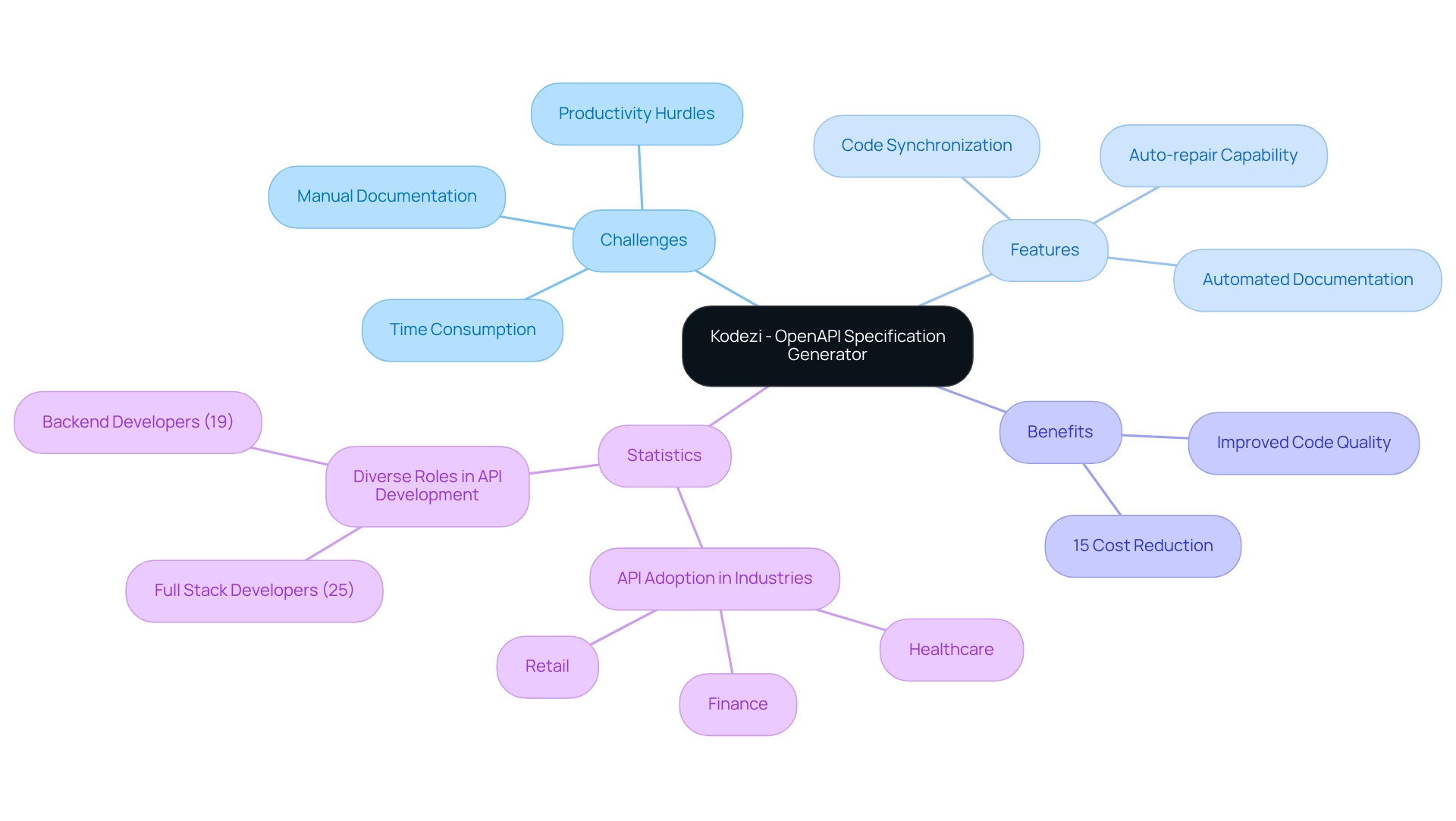
Understanding Zed Pricing: Key Factors Influencing Costs for Developers
Developers often face significant coding challenges that can impact their productivity and efficiency. Understanding the zed price is crucial for effectively optimizing expenses. Essential factors influencing these costs include the features available in each plan, the level of AI integration, and expected usage patterns. Developers should carefully assess their specific task requirements, the number of users involved, and the frequency of software usage. By grasping these elements, programmers can make informed decisions about which cost level, or zed price, best fits their needs, ensuring they access essential tools without overspending. Furthermore, current trends indicate that software cost structures are becoming increasingly adaptable, allowing developers to tailor their subscriptions based on actual usage and project demands. Kodezi offers a structured cost model with credit tiers of 8K, 12K, 25K, 75K, and 80K credits, available in both monthly and annual options. This flexibility is designed to accommodate varying scopes and budgets, helping developers manage costs efficiently. The pricing structure encompasses various tool types, including:
- Code generation
- Debugging (medium and high accuracy)
- Documentation
- Conversion
- Transformation
Each of these has specific credit costs that users should consider when selecting their plan.
In addition, to further optimize costs, professionals might contemplate establishing a center of excellence within their teams. This center would focus on selecting and implementing criteria that align with their project needs. This approach not only streamlines software usage but also enhances overall productivity. By actively engaging with Kodezi's promotional strategies, such as free trials and demos, users can explore the platform's capabilities and ensure they are maximizing their investments in software solutions.
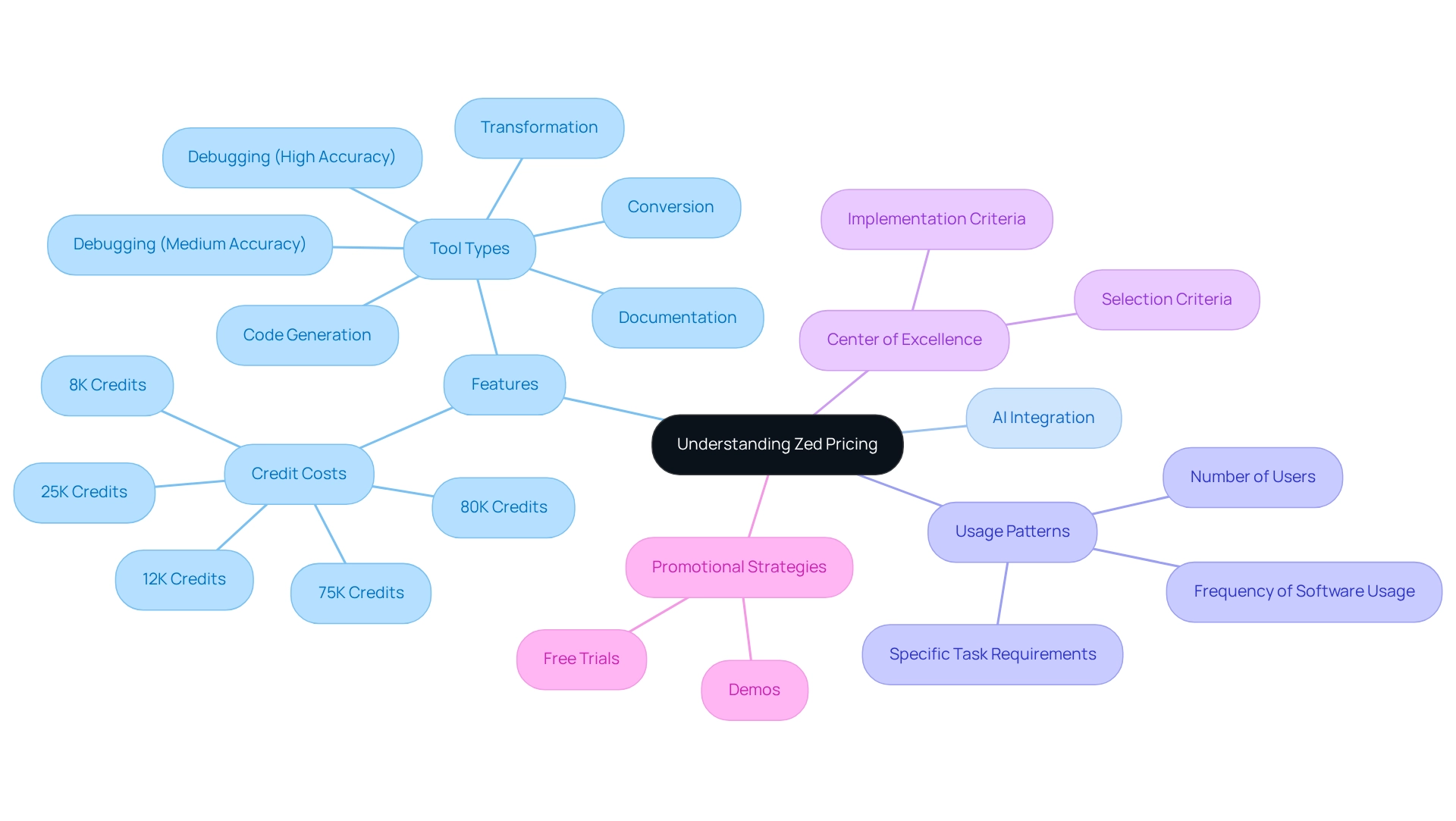
Comparing Zed Pricing Across Platforms: What Developers Need to Know
When developers confront the challenges of coding across various platforms, they must consider the features available at each price point. Although some platforms may showcase lower initial costs, the Zed price often reflects the critical functionalities that Zed provides, such as advanced AI capabilities and enhanced collaboration tools. As Sameer, a writer at Apptunix, points out, "AI is essential in making software development more efficient by automating repetitive coding tasks, which greatly shortens development time."
A comprehensive assessment of the total cost of ownership is crucial, as it includes not only the upfront pricing but also potential hidden costs that may surface during the development process. For example, integrating AI features into applications can significantly increase expenses, sometimes by $50,000 or more, while compliance with regulations like GDPR and HIPAA may necessitate additional investments ranging from $10,000 to $50,000.
Furthermore, a case study on the estimated cost of developing a SaaS application similar to Trello indicates that companies should budget between $100,000 and $300,000, depending on the complexity of the project. By understanding these factors, including the hidden costs associated with various features, developers can make more informed decisions that align with their needs and budget constraints.
In addition, when comparing Zed price with other platforms, it is essential to recognize that it is often referred to as the 'Swiss-Army Knife' for programmers, offering versatile tools that enhance productivity and code quality. The CLI independently improves codebases and resolves issues before production, significantly impacting overall costs and efficiency. Developers are encouraged to explore Kodezi to optimize their coding processes and experience its unique advantages firsthand.
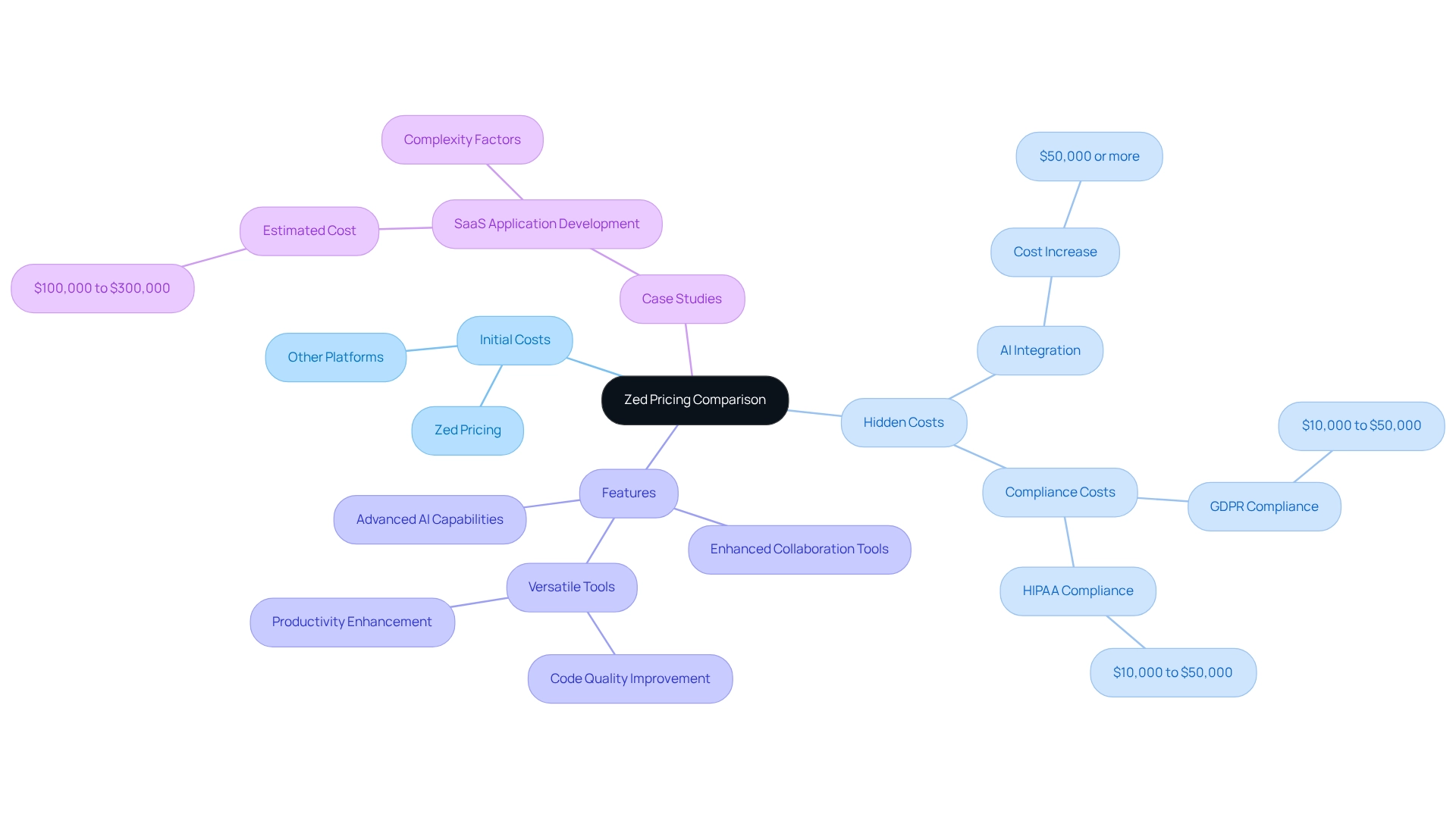
Zed Pricing and Project Timelines: How Costs Affect Development Schedules
The zed price framework significantly affects development timelines, presenting a common challenge for developers. Higher-tier plans are often equipped with advanced features, such as enhanced AI support and superior collaboration tools, which can substantially expedite development processes. For instance, initiatives utilizing these premium features have demonstrated a reduction in development time by up to 30%, allowing teams to meet tight deadlines more efficiently.
Conversely, opting for a lower-tier plan may lead to extended development timelines due to restricted access to essential tools and functionalities. This limitation can cause delays, as teams might grapple with inefficient workflows or lack the necessary resources to address complex challenges swiftly. A study indicated that initiatives with limited cost alternatives encountered delays of 15-20% compared to those with more flexible plans. Furthermore, clients must be prepared to oversee dedicated teams, as effective communication is vital for successfully navigating tailored software initiatives. Developers are encouraged to carefully evaluate their development requirements and timelines when selecting a zed price for their pricing plan. Aligning the chosen plan with timelines is crucial to minimize potential delays. For example, managers have noted that investing in higher-tier plans not only accelerates development but also enhances overall control, resulting in improved communication and collaboration among team members. Indeed, when integrating project control support, project management expenses could increase by 9-15%, underscoring the importance of selecting the right cost level.
Ultimately, understanding the impact of costs on software development speed is essential for developers aiming to enhance their workflows and complete projects on time. By selecting the appropriate cost level, teams can ensure they possess the necessary tools to effectively manage the complexities of software development. As demonstrated by Coreteka's flexible cost structures, offering various financial options can enhance control, flexibility, and communication throughout the development process. To further boost your coding efficiency, why not explore Kodezi's free trials and demos? These offerings provide access to advanced features that can significantly improve your development timelines.
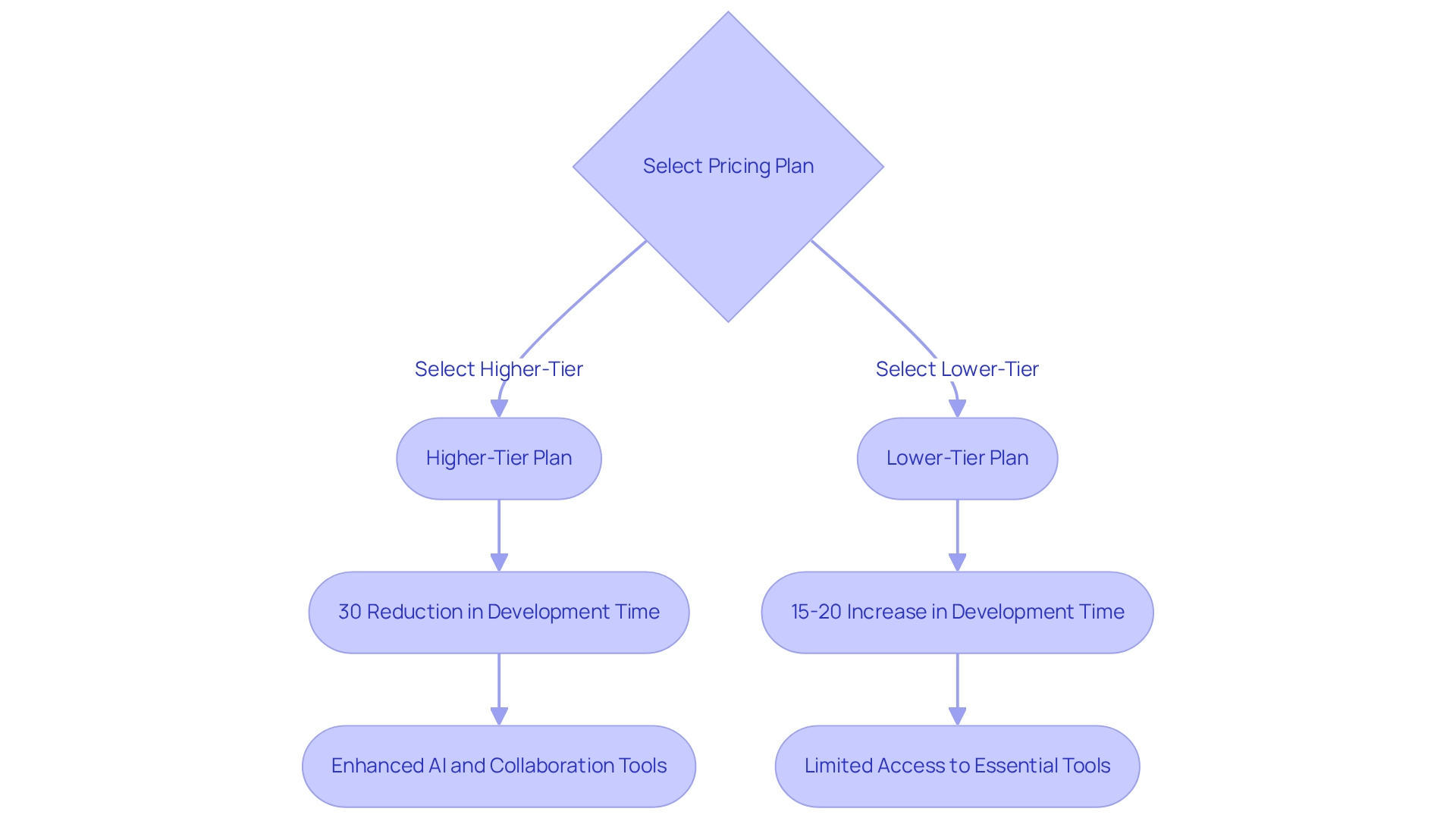
Resource Allocation Strategies: Maximizing Value with Zed Pricing
Developers often face significant coding challenges that can hinder productivity and efficiency. To address these issues, Kodezi offers a suite of features designed to streamline the coding process and enhance collaboration. By adopting strategic resource allocation practices, teams can maximize value using the zed price. This begins with a thorough assessment of team needs to select the most suitable plan that provides essential features without unnecessary expenditure.
Utilizing project management tools to systematically monitor workload can further enhance this assessment. Furthermore, by leveraging Zed's collaborative tools and enhancing productivity with the zed price powerful debugging capabilities, teams can significantly boost their overall efficiency. This ensures that all members effectively utilize the resources available. The platform has been praised by developers for its ability to enhance coding efficiency and streamline debugging processes. As one software engineer noted, 'I love what Kodezi is doing with debugging; it feels like I just unlocked a new superpower!'
In addition, cross-training team members is recommended to allow for more flexible resource reallocation when unexpected issues arise. This approach not only justifies the investment in higher-tier plans but also addresses the 42% of teams that struggle with inadequate communication regarding capacity, as highlighted in recent surveys. Moreover, concentrating on user-centered design in management tools has been demonstrated to improve productivity and user satisfaction. By explicitly aligning tool selection with team dynamics, developers can optimize their software investments and drive greater efficiency in their projects.
To implement these strategies effectively, teams should regularly review their resource allocation and adjust their plans based on evolving needs. Consider incorporating Kodezi CLI, the 'B2B Swiss Army Knife for Engineering Teams,' to autonomously improve code quality and fix bugs before they reach production. Are you ready to explore the tools available on the Kodezi platform and unlock your team's full potential?

Staying Informed: Tracking Zed Pricing Trends for Better Decision-Making
Developers face significant challenges when it comes to managing subscription costs effectively. To navigate these complexities, it is crucial for them to proactively monitor zed price trends. This can be accomplished by:
- Subscribing to industry newsletters
- Following reputable blogs
- Engaging in forums dedicated to pricing discussions
By staying informed, professionals can anticipate potential price increases or promotional offers, enabling them to adjust their plans strategically and optimize their budgets.
With 213 plan changes recorded across the Pricing 500 Index, being informed is essential for preventing unnecessary expenses. Are you aware of how much you might be overpaying for your software solutions? Many businesses likely face inflated costs due to a lack of clarity in SaaS pricing, making it vital for creators to keep a close eye on the zed price trends. Expert advice underscores that tracking these trends can lead to significant cost efficiencies. For instance, Revenue Management Labs demonstrated that by achieving cost efficiencies, such as reducing hiring costs by 15-20%, they successfully repositioned the product, resulting in a remarkable 30% increase in adoption rates.
Furthermore, the introduction of add-ons by Chili Piper, which allows customers to pay for results, illustrates the evolving cost models within the industry. This reinforces the necessity of staying informed about rate changes. By incorporating these strategies into their daily routines, programmers can enhance overall productivity and resource distribution. Are you ready to take control of your subscription costs and improve your coding efficiency?
Zed Pricing and Code Quality: Investing Wisely for Optimal Results
Investing in Zed's higher-tier pricing plans can significantly improve code quality and the zed price, addressing common coding challenges developers face. Advanced features such as debugging tools, AI-assisted coding, and real-time collaboration streamline the development process, leading to cleaner and more efficient code. Have you considered the long-term advantages of utilizing quality tools? While initial costs may seem high, they are often outweighed by the reduction in bugs and enhanced maintainability of the codebase.
Furthermore, a third of programmers indicate that their performance is assessed based on the amount of code generated. This fact underscores the necessity for tools that not only enhance output but also elevate the quality of that output. In addition, thorough documentation accelerates the integration of new team members, promoting quicker productivity improvements. By investing in higher-tier plans, programmers can ensure their code meets professional standards, fostering sustainable development and long-term success in an evolving tech landscape, especially considering the zed price associated with Kodezi's CLI, which offers automated code debugging and optimization functionalities that greatly enhance code quality. This makes it a valuable resource for individuals aiming to improve their coding practices. User testimonials highlight Kodezi's transformative effect on debugging and productivity, with over 1,000,000 users praising its ability to simplify the coding process.
An Enterprise Technology Leader emphasized the importance of considering the potential for significant productivity increases when planning future projects. This aligns with insights from a case study on technical debt, which points out the long-term costs of neglecting code quality. By investing in higher-tier plans, programmers can mitigate these risks and concentrate on high-impact areas for debt reduction. Explore the tools available on Kodezi's platform today to elevate your coding experience.
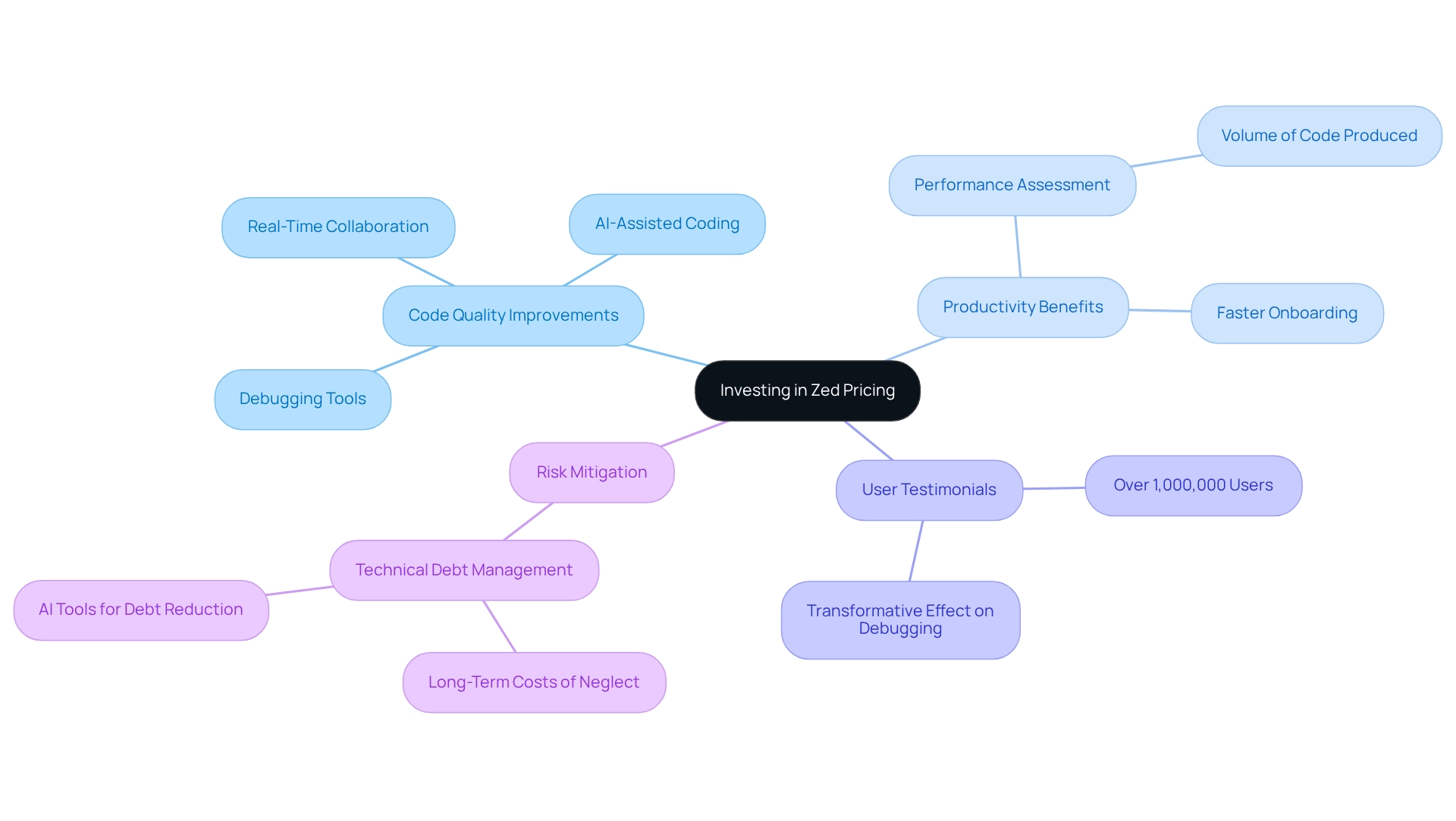
Community Insights: Learning from Others' Experiences with Zed Pricing
Developers often face significant coding challenges. One way to overcome these hurdles is by actively engaging in community discussions. Online forums, social media groups, and developer meetups serve as essential platforms for sharing experiences and evaluating the benefits and drawbacks of various payment plans, such as the zed price. By connecting with peers, developers can gain a deeper understanding of available options and see how collective experiences influence purchasing decisions.
Research indicates that 90% of communities utilize member suggestions to enhance products and services. This underlines the importance of community feedback in shaping effective cost strategies. Furthermore, the longevity of online communities has increased; the percentage of communities existing for more than five years rose from 28% in 2017 to 49% in 2021. This trend suggests a growing stability and maturity within the community landscape, enhancing the reliability of shared insights.
As one expert noted, "When your brand has a thriving community, your content doesn’t rely on the algorithm alone." This statement highlights that community engagement not only aids in understanding the zed price but also contributes to the broader success of the brand. By participating in these discussions, individuals can make more informed choices that align with their specific needs and budget, ultimately enhancing their overall success with Zed.
To maximize these benefits, programmers should actively participate in discussions, ask questions, and share their own experiences. This fosters a collaborative environment that benefits all members. Additionally, programmers can explore Kodezi's features, such as free trials and demos, to further improve their coding abilities and make informed choices based on community insights.
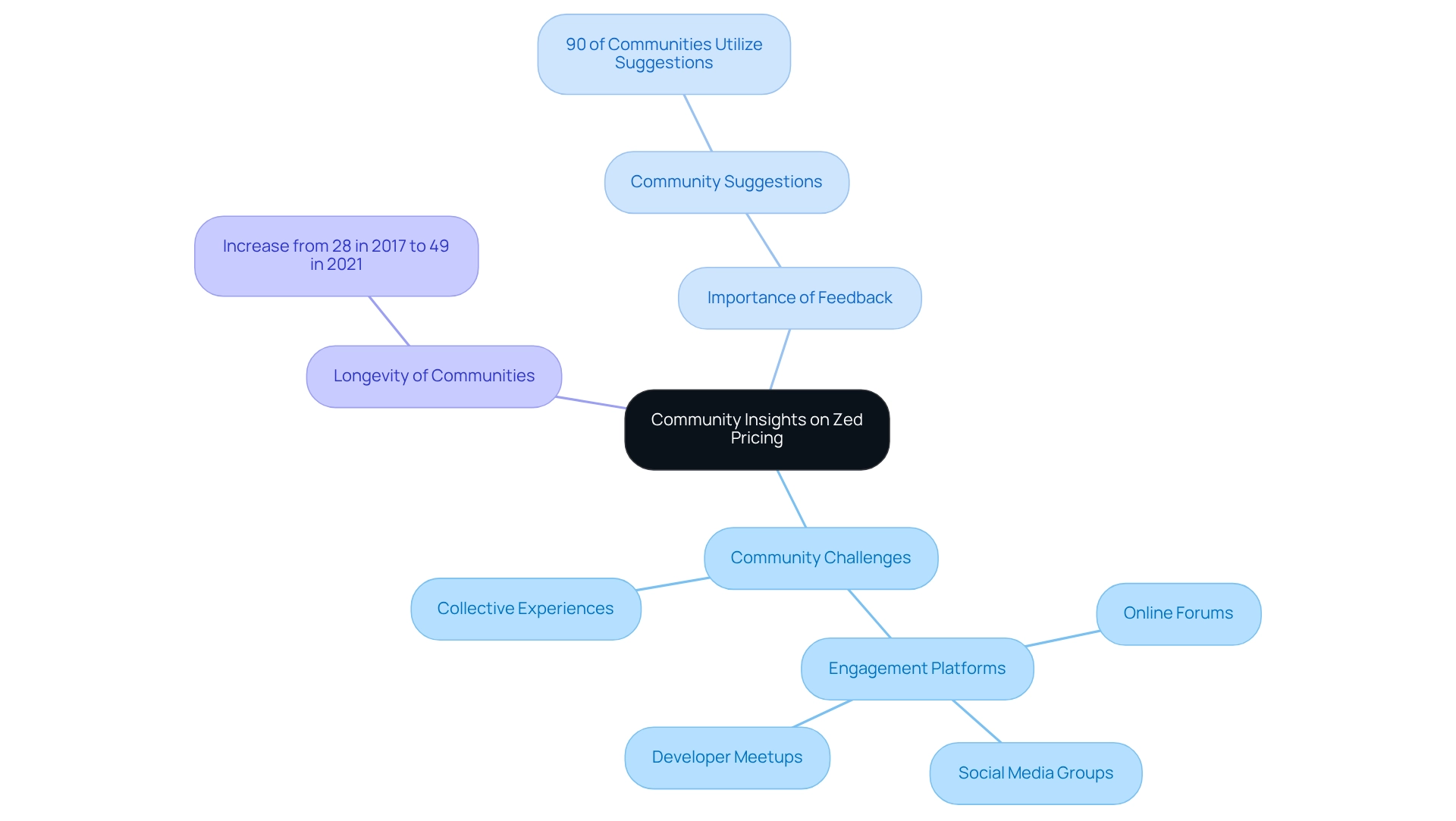
Future Trends in Zed Pricing: What Developers Should Anticipate
As the software development landscape evolves, developers face coding challenges that require attention. One significant aspect to consider is the potential changes in zed price models, which may involve new cost tiers and modifications in feature availability. Recent trends reveal that many companies are raising prices, especially in their mid-tier offerings, with an average increase of around 16%. This shift reflects a broader strategy among SaaS providers to monetize their middle tiers more effectively.
Furthermore, a case study titled "Wider Pricing Trends in SaaS" documented a total of 126 pricing changes among the PricingSaaS 500, with most being price increases across various categories. Such insights highlight the necessity for programmers to adjust their strategies in response to these shifts. As Ma. Lorena Gumafelix Emperado, a seasoned content writer, notes, "Businesses must adapt to new tools and strategies to remain competitive in the evolving software market." By staying informed about these advancements, programmers can position themselves for success in an increasingly competitive environment.
In addition, to enhance their programming skills and adapt to these cost alterations, programmers can explore the services offered. With options to 'Get Started for Free' and 'Get a Demo,' this platform provides valuable resources that can assist programmers in navigating the evolving landscape effectively. By leveraging these tools, developers can improve their productivity and code quality, ensuring they remain competitive in the industry.
Actionable Strategies: Leveraging Zed Pricing for Development Success
Developers often face significant challenges in coding, from debugging to optimizing their workflows. Kodezi addresses these issues with its AI-assisted development tool, which automatically corrects code, optimizes, and debugs—making it suitable for programmers at any skill level. Imagine having a tool that acts as an autocorrect mechanism for your code, detecting and resolving errors while offering clarifications. This not only improves your coding experience but also enhances productivity.
In addition, Kodezi prioritizes user privacy by ensuring that all code and data are securely processed in the user's browser without being shared. This commitment to security fosters trust among users. Furthermore, collaboration within teams is crucial; when all members utilize the tools efficiently, it can significantly enhance the return on investment in Zed. By aligning team efforts and evaluating usage patterns, developers can optimize their software strategies and drive greater success.
Have you considered the emotional advantages of products? Recognizing these can validate increased costs and influence buying choices, making it essential to understand how Zed's cost strategies can enhance development results. Moreover, with the implementation of new software now taking about 7 hours—down from 57 hours a decade ago—developers can experience remarkable efficiency gains by utilizing the zed price and tools. By leveraging these insights, teams can maximize their productivity and streamline their development processes.
Kodezi also offers a 7-day free trial, allowing users to experience its features firsthand. This opportunity not only enhances coding skills but also boosts engagement. Why not explore the tools available on the platform and see how they can transform your coding experience?
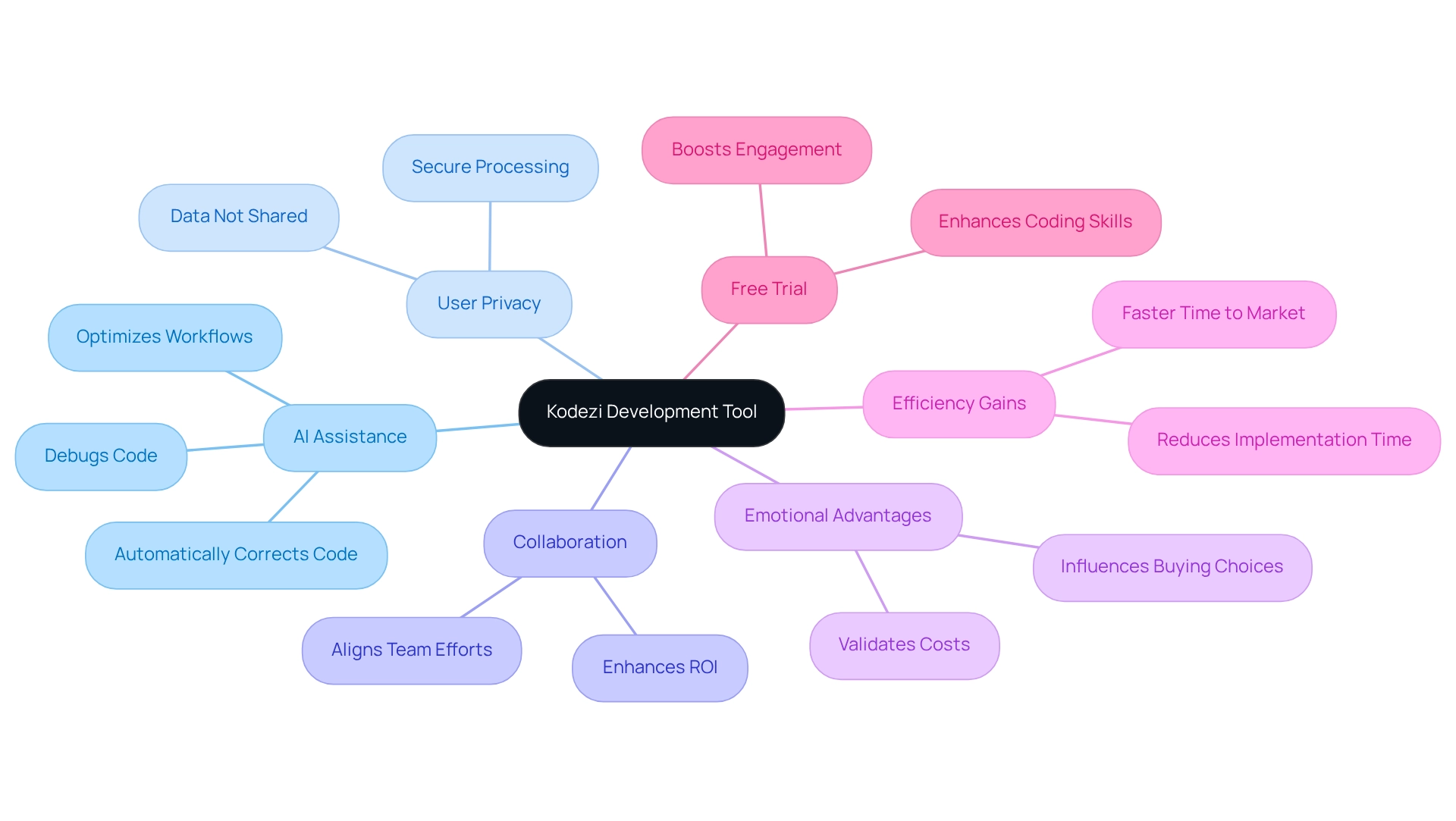
Conclusion
The exploration of Zed pricing highlights the significant challenges developers face in software development, such as managing costs, project timelines, and code quality. By grasping the essential elements that influence pricing models, developers can make informed decisions tailored to their specific project needs and budget constraints. The flexibility provided by Zed pricing, along with tools like Kodezi, empowers teams to optimize workflows while ensuring access to crucial features that boost productivity and maintainability.
Furthermore, the value of community insights and awareness of pricing trends is paramount. How often do you engage with peers to gain fresh perspectives? Participating in discussions can provide developers with valuable insights that inform their purchasing choices. As the software landscape evolves, being proactive in monitoring pricing changes and adjusting strategies is vital for maintaining a competitive edge.
In addition, investing wisely in higher-tier pricing plans can lead to significant enhancements in code quality and project efficiency. Have you considered how advanced features and tools can reduce development time? By leveraging these resources, developers can improve collaboration and produce cleaner, more maintainable code. Embracing these strategies not only drives immediate project success but also lays the groundwork for sustainable growth in an ever-changing tech environment.
Frequently Asked Questions
What is Kodezi and how does it benefit developers?
Kodezi is a versatile tool designed to enhance programming productivity by automating the creation of API documentation. It saves time, ensures adherence to professional standards, and allows developers to focus on coding rather than manual documentation tasks.
How does Kodezi improve coding productivity?
Kodezi simplifies the documentation process, which boosts productivity and improves code maintainability. This enables teams to adapt quickly to evolving project requirements, ultimately enhancing overall development efficiency.
What features does Kodezi offer for API development?
Kodezi offers features such as automated code assessments, synchronization of API documentation with code modifications, and a command-line interface (CLI) that can auto-repair codebases. These features help teams focus on API design, governance, and security.
What are the financial benefits of using Kodezi?
Companies using Kodezi can achieve a 15% decrease in expenses by employing it for API documentation, highlighting its tangible benefits in reducing costs while enhancing productivity.
What pricing structure does Kodezi offer?
Kodezi has a structured cost model with credit tiers of 8K, 12K, 25K, 75K, and 80K credits, available in both monthly and annual options. This flexibility accommodates varying scopes and budgets for developers.
What factors should developers consider when assessing the Zed price?
Developers should consider features available at each price point, the level of AI integration, expected usage patterns, and the total cost of ownership, which includes potential hidden costs associated with advanced functionalities.
How does Kodezi support different roles in API development?
Kodezi is particularly significant for various programming profiles, with full-stack programmers being the largest segment at 25%. Its features cater to diverse roles, enhancing productivity across the board in API development.
What should developers do to explore Kodezi's capabilities?
Developers are encouraged to engage with Kodezi's promotional strategies, such as free trials and demos, to explore the platform's capabilities and ensure they are maximizing their investments in software solutions.




